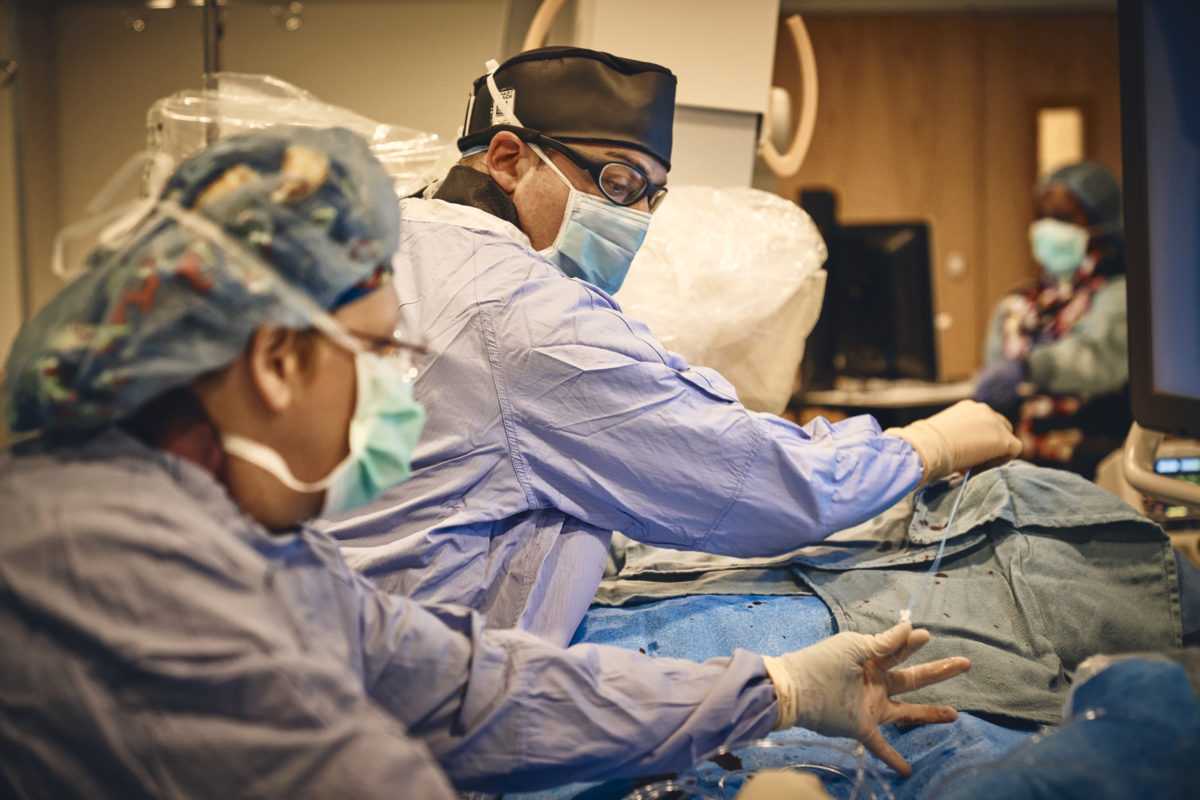Advancements in interventional heart and vascular health are saving lives — and improving the quality of life for patients.

Last fall, more than 40 professionals learned from clinical experts about the latest advances in devices, procedures and care at the fifth annual Heart and Vascular Interventional Services Conference at the John H. Ammon Medical Education Center at Christiana Hospital.
Felisha E. Alderson, MSN, RN, CRRN, clinical operations director for Heart and Vascular services, and colleagues highlight five takeaways from the event.
Imaging pathways are advancing stroke care.
Technology is driving changes in stroke care. CT profusion studies allow physicians to see whether an intervention will have an impact on the patient’s outcome and plays a key role in preventing deficits.
“We are now able to treat patients who have gone beyond the 6 to 8 hour window for successful care, extending that opportunity to 24 hours—and sometimes even longer,” she said. “In the recent past, patients who went to bed and woke up with a deficit couldn’t be treated. Now, sometimes, they can.”
Faster studies also mean patients can get help sooner. A key intervention is delivering clot-busting drugs to patients who have suffered ischemic strokes, which are caused by blockages.
At Christiana Care, the goal for door-to-needle time is less than 45 minutes. To date in 2019, the team has achieved an average of 25 minutes. The door-to-puncture goal is 75 minutes; so far this year, the rate is 46 minutes.
Micra is the next generation of pacemakers.
Less than 10 percent the size of a standard pacemaker, the Micra is comparable to a large vitamin capsule. Four tines attach the device into right ventricle and eliminate need for leads.
Because it goes in through the vein, it’s much less invasive.
The Micra-pacer is usually used to treat bradycardia, or low heart rate, for patients who only need a single chamber to be paced.
The device doesn’t impinge on the bicuspid valve and the complication rate is low, less than 4 percent, compared to average of 12 percent in standard pacemakers. Because there is no surgical pocket, there are no pocket complications, such as infection.
“It would be a good option for someone who plays tennis and might worry about the leads being dislodged,” Alderson said.
You can’t see it under the skin, as you can with a standard pacemaker. There are fewer activity restrictions and patients can get an MRI, which they can’t with a traditional pacemaker. It won’t set off the security system at the airport.
The battery life is 10 to 12 years. When the battery needs to be replaced, a new device is simply inserted.
Prostate artery embolization is less invasive.
As men age, the prostate grows. An enlarged prostate affects about half of men ages 51 to 60 and as many as 90 percent of men older than age 80. Often, they have problems with their urinary tract because the enlarged prostate impedes the flow of urine.
Usually medications can help. But for men for whom medications don’t work, prostate artery embolization is an option.
“Prostate artery embolization is the new and exciting treatment option for those suffering from an enlarged prostate,” said Christopher J. Grilli, D.O., vascular and interventional radiology specialist. “This interventional advancement allows treatment without having to undergo invasive surgical procedures. This is a win-win.”
Before prostate artery embolization, the treatment was transurethral resection of the prostate, a surgery in which tissue is removed. Prostate artery embolization is a same-day procedure performed in the interventional radiology lab. In prostate artery embolization, tiny round microspheres are injected through a catheter and into the blood vessels that feed the prostate to reduce its blood supply.
When blood flow to the artery is blocked, it allows the urethra to expand and resolves urinary tract problems. Minor side effects, such as burning, subside quickly.
LVAD education helps patients and families lead healthier lives.
A left ventricular assist device or LVAD takes over the pumping work of the left ventricle in patients with heart failure. Originally, it was a bridge to transplant, a big bulky machine that kept patients alive until a donor heart was obtained. Today, the devices are much smaller and can be carried in a fanny pack.
For many patients, LVAD is now a destination therapy, a device they will rely on for the rest of their lives. Without it, they would be bedridden or dead. With the LVAD, they can lead active lives.
The Heart Failure team at Christiana Care educates the entire family on care and maintenance of the device.
“You have to be compliant because if it stops working, so does your heart,” Alderson says. “It’s also important to know signs of stroke, heart attack or DVT (deep vein thrombosis).”
Extensive education is a key to success. Everyone has to be onboard, making sure patients have batteries with them and batteries charging at home at all times. To prevent clots, patients must take blood thinners, which can cause complications with bleeding. Patients should not use a straight razor to shave and should fall proof their homes.
The team also teaches patients and their support people to clean the site and watch for signs of infection and what to do if the device malfunctions. If patients are transported by ambulance, they must let the emergency medical team know they won’t have normal blood pressure reading because the device is pumping, not the heart. The team trains first responders not to perform CPR on LVAD patients and risk breaking the device.
There’s an extra layer of care from the LVAD team, which has a staff member on call 24/7.
STEMI coordination speeds care for patients.
When someone suffers a serious heart attack, every second matters.
Christiana Care’s STEMI coordinator works with county and state emergency medical services to recognize a STEMI (ST-segment elevation myocardial infarction) before the patient arrives at the hospital.
“Our EMS providers tell us that the patient has a STEMI so a physician can be ready and waiting in the Emergency Department to send them directly to the cardiac catherization lab,” Alderson said.
In fiscal year 2018, more than 75 percent of STEMI codes resulted in interventions. STEMI coordination reduced door-to-balloon time by 16 minutes to 31 minutes. That’s a big difference.
Currently, 98.5 percent of U.S. hospitals maintain a myocardial infarction registry. Of those hospitals, Christiana Care ranks in the 90th percentile in response time.



